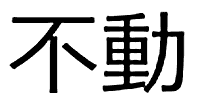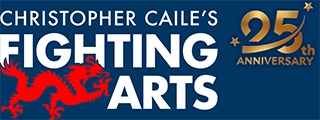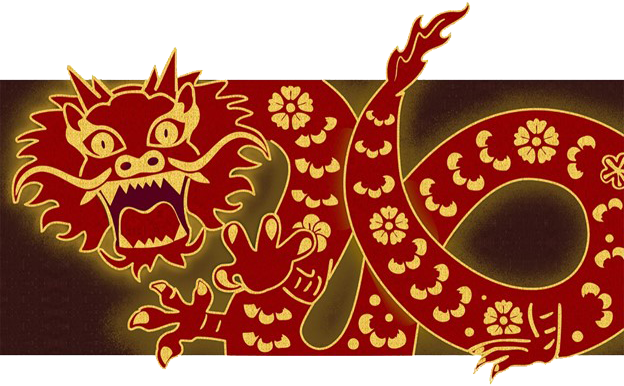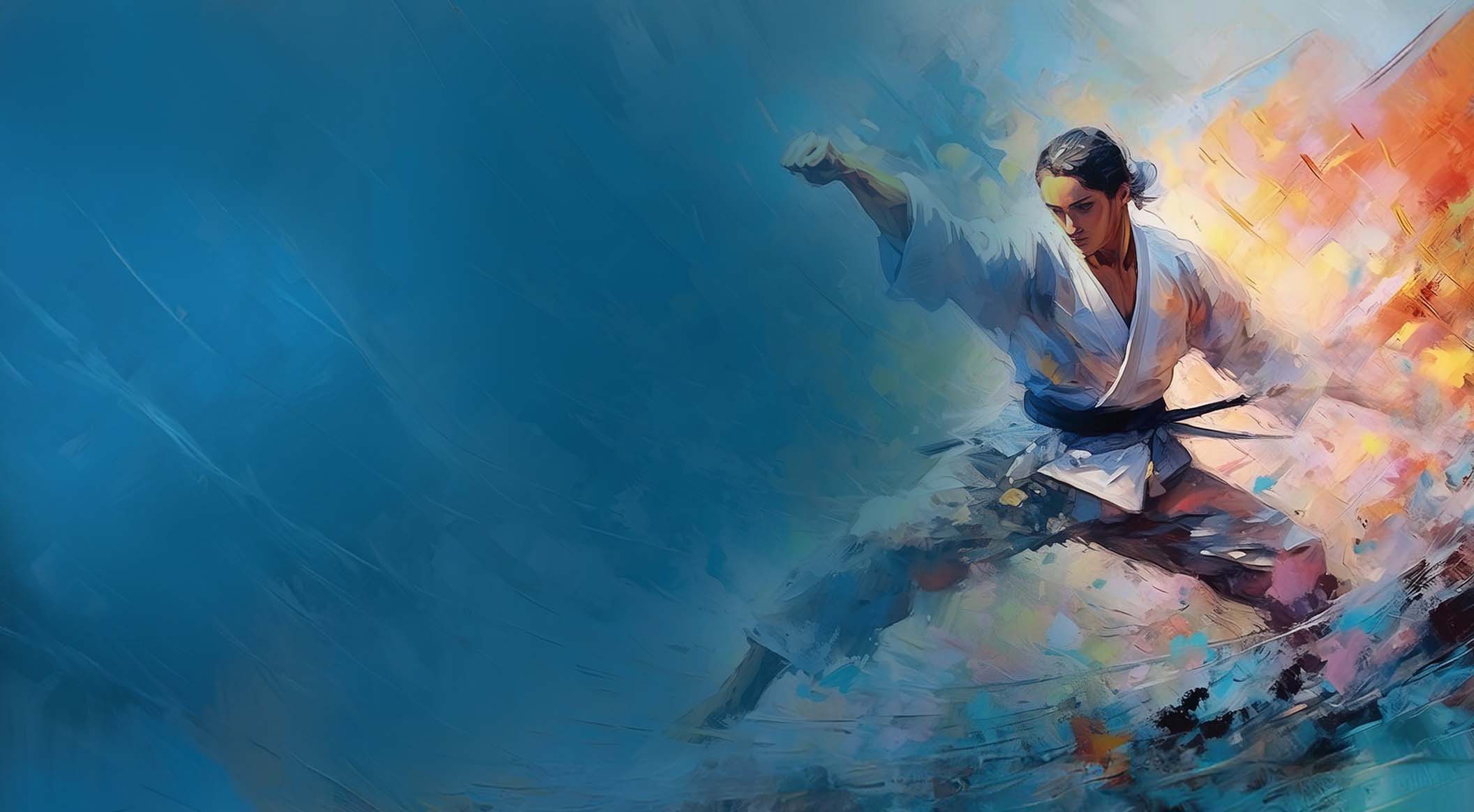Fudo:
The Concept of Immovability
By Christopher Caile

Fudo is an English translation of two characters (Japanese kanji), "Fu" translates as "not" (left character) and the second (a compound character of "strength" (right most character) and "heavy" (middle character) combine to mean "move." In other words the characters used for "Fudo" combine to mean "not move" or in better English, immovable, immovability or stability.
Fudo is a Japanese term often used in Buddhism, especially in Zen and Esoteric Buddhism (Mikkyo) to represent a mental state — one of immovability, not physically or literally, but in mind, one that is not captured, or moved, or dwells, or loiters on a thought or in a focus – a total unobstructed awareness and focus on everything, thus not moving with, or fixed upon something (limited by a focused attention).
In the martial arts the character "shin," meaning spirit, heart or will, is often added to the root "fudo" to become "fudoshin," a term meaning calm spirit, even when faced with danger, without fear or confusion, that does not dwell or become fixed on anything. This was the highest attainment of spiritual skill only attainable when the mind is totally focused on the totality of sensory input and free of thoughts and emotions – detached but aware and present. A related term "mushin" also is often used to mean "without mind" (not occupied by thought or emotion). (1)
Using the "fudo" root, other related terms include "fudo-chi," meaning immovable spirit or wisdom that can't be influenced, or confused, "fudotai" or immovable body, and "fudoshise" or immovable stance and "fudo-dachi" or "immovable stance" also sometimes referred to as a "preparation stance" (as in the initial and final stance in kata, one that allows the participant freedom of movement and action in any direction).

Fudo Myo-o, a Japanese deity (also know as Acala), the God of Fire, a manifestation of the central sun (Vairocana), a fierce God of Indian origin although neither a Buddha nor Bodhisattva. A male, he is usually portrayed as livid blue in color with a terrible facial expression standing or sitting on a rock surrounded by flames, gripping a sword in the right hand, a rope in the left, teeth bared and with angry eyes. He is an important ancient Japanese deity (considered a guardian of Buddhism), revered by Buddhists, especially by the Shingon sect of Esoteric Buddhism (Mikkyo), this branch of Buddhism being a religious practice of many Japanese Samurai in feudal times whose fierce face and inner calmness and strength were attributes highly prized.
Many Japanese Samurai practiced Esoteric Buddhism (Mikkyo), (2) especially revering the deity Fudo Myo-o. They saw themselves as guardians of order in a nation besieged with disorder just as Fudo Myo-o served as a guardian of Buddhism. Fudo Myo-o also represented the highest attainment of the Samurai state of mind — the mind that does not move, and the body that is not unsettled even when surrounded by danger. Because of this reverence, statues and brushed images of this deity were very popular. Images of Fudo Myo-o also often adorned samurai armor and weapons.
The concept of "Fudo" is also important to martial artists. The famous Zen priest Takuan in his famous three part treatise titled "Fudochi Shinmyoroku" ("The Mysterious Records of Immovable Wisdom") identifies Fudo-Myo-o attributes as they apply to Japanese (Samurai) swordsmanship. He notes the Fudo Myo-o's grasp of the sword in his right hand, his body standing firmly with mind immovable (detached and not distracted), looking at something but not stopping the mind during a flow of action or combat. He warned the Samurai against stopping the mind on a particular object, emotion or thought, noting that such stopping clutters (stops) the mind, something that curtailed the performance of technique.
The most famous Japanese swordsman known today is Miyemoto Masashi. He too was influenced by Fudo Myo-o. "Fudo" and its derivative concepts (noted above) represent a central concept in Masashi's strategy of combat (that reflect Takuan's tenets), (3) ideas he later encapsulated in his famous text on strategy, "The Book of Five Rings."
Even today many martial artists use Zazen (seated Zen meditation), chants (some derived from Esoteric Buddhism), and other to clear, fortify and purify the mind. Standing and/or meditating under a cold waterfall is another similar practice. Morihei Ueshiba, the founder of Aikido, is famous for this practice (which he termed Misogi) of ritual purification. (4)
It should be noted, however, that in modern times most martial artists who use these practices do so to enhance their mental and spiritual discipline, and to clarity their awareness and mind, ends that are separate from any religion or religious doctrine.
Modern martial artists also express similar concepts of the immovable mind. Mas Oyama (founder of Kyokushinkai karate and one of my first karate teachers), for example, used to tell me that the ideal karate mind is that of a person who could walk through a burning building without fear — a very Fudo Myo-o image.
Kaicho Tadashi Nakamura (founder of Seido Karate and my current karate teacher) has said that a true karate-ka must be present in the now, the present moment, totally absorbed in action, mind void of distraction (thought or emotion) and spirit supreme.
Author's Note:
Two other articles on FightingArts.com give practical advice related to the concept of "no mind." See: "Fighting Zen – How Meditation Can Enhance Your Fighting Skills" and is "Controlling The Flinch, The Blink and The Turn Away."
Footnotes:
1-Mushin or "no mind" is also a very popular concept in Zen where meditation is used to free the mind of thought or emotions while simultaneously developing awareness, and focus, not on just one spot or image, but on everything perceived.
2-Few Samurai before the Edo period actually practiced Zen, although later it became popular.
3-Masashi is also noted for his brushwork and drawings, one being a remarkable 18 inch high wood carving he made of Fudo Myo-o. Masashi is also known for his practice of ritually purifying himself under ice cold waterfalls. There is no evidence, however, that Masashi actually practiced esoteric Mikkyo Buddhism in addition to his study of Zen, although he was influenced by Fudo Myo-o.
4-When I visited Ueshiba's summer retreat and dojo in Iwama, Japan in 1994 (later the home dojo of Seito Sensei), students talked about the waterfall in the nearby hills that Ueshiba has often used for this practice.
About the Author Christopher Caile

Screenshot
Christopher Caile is the Founder and Editor-In-Chief of FightingArts.com. He has been a student of the martial arts for over 65 years.
He first started in judo while in college. Then he added karate as a student of Phil Koeppel in 1959 studying Kempo and Wado-Ryu karate. He later added Shotokan Karate where he was promoted to brown belt and taught beginner classes. In 1960 while living in Finland, Caile introduced karate to that country and placed fourth in that nation's first national judo tournament.
Wanting to further his karate studies, Caile then hitch hiked from Finland to Japan traveling through Scandinavia, Europe, North Africa, the Middle East and South and Southeast Asia — living on 25 cents a day and often sleeping outside.
Arriving in Japan (1962), Caile was introduced to Mas Oyama and his fledgling full contact Kyokushinkai Karate by Donn Draeger, the famous martial artist and historian. Donn also housed him with several other senior international judo practitioners. Donn became Caile's martial arts mentor, coaching him in judo and introducing him to Shinto Muso-ryu under Takaji Shimizu.
Caile studied at Oyama's honbu dojo and also at Kenji Kurosaki's second Tokyo Kyokushinkai dojo. In his first day in class Oyama asked Caile to teach English to his chief instructor, Tadashi Nakamura. They have been friends ever since. Caile also participated in Oyama's masterwork book, "This Is Karate."
Caile left Japan with his black belt and designation as Branch Chief, the first in the US to have had extensive training in Japan directly under Oyama Sensei. As such, Oyama Sensei asked him to be his representative on visits to his US dojos to report on their status.
A little over a year later, Nakamura, Kusosaki and Akio Fujihira won an epic David vs. Goliath challenge match against Thailand's professional Muay Thai Boxers in Bangkok, Thailand, thrusting Kyolushinkai and Nakamura into national prominence.
Back in the US Caile taught Kyokushinkai karate in Peoria, Il while in college and later in Washington, DC. while in graduate school. Durimg this time Shihan Nakamura had moved to New York City to head Kyokushinkai's North American Operation.
In 1976 when Kaicho Tadashi Nakamura formed the World Seido Karate organization, Caile followed. Living then in Buffalo, NY, Caile taught Seido karate and self-defense at the State University of New York at Buffalo (SUNY Buffalo) for over 15 years where he also frequently lectured on martial arts and Zen in courses on Japanese culture.
Caile moved to New York City in 1999 to marry Jackie Veit. He is now an 8th degree black belt, Hanshi, training in Seido Karate's Westchester, NY Johshin Honzan (Spiritual Center) dojo. In Seido Caile is known for his teaching of and seminars on kata applications. He also produced a 14 segment video series on Pinan kata Bunkai currently available to Seido members.
Caile is also a long-time student and Shihan in Aikido. He studied in Buffalo, under Mike Hawley Shihan, and then under Wadokai Aikido's founder, the late Roy Suenaka (uchi deshi under Morihei Ueshiba, founder of Aikido and was Shihan under Tohei Sensei). In karate, Suenaka (8thdan) was also an in-house student of the Okinawan karate master Hohan Soken.
Having moved to New York City, Caile in 2000 founded this martial arts educational website, FightingArts.com. Twenty-five years later, in 2025, it underwent a major update and revision.
For FightingArts.com and other publications Caile wrote hundreds of articles on karate, martial arts, Japanese art, Chinese Medicine and edited a book on Zen. He also developed relationships with a cross section of leading martial arts teachers. Over the last four decades he has conducted extensive private research into karate and martial arts including private translations of the once secret Okinawan hand copied and passed on Kung Fu book, the Bubishi, as well as an early karate book by the karate master Kenwa Mabuni. He periodically returns to Japan and Okinawa to continue his studies and participate Seido karate events. In Tokyo he practiced (with Roy Suenaka Sensei) in a variety of aikido organizations with their founders – including private interviews and practices at the Aiki-kai Aikido Honbu dojo with the son and grandson of aikido's founder, Doshu (headmaster) Kisshomaru (an old uchi-deshi friend) and his son, Moriteru Ueshiba and in Iwama with Morihiro Saito. On Okinawa he studied Goju Ryu karate under Eiichi Miyazato, 10th dan founder of Naha's Jundokan, and also with Yoshitaka Taira (who later formed his own organization, who specialized in kata Bunkai. While there Caile also trained with Hohan Soken's senior student, Master Fusei Kise, 10 dan as well as with the grandson of the legendary karate master Anko Itosu.
Caile's other martial arts experience includes: Diato-ryu Aikijujitsu and Kenjitsu, kobudo, boxing, Muay Thai, MMA, Kali (empty hand, knife and bolo), study of old Okinawan Shoran-ryu & Tomari body mechanics, study of old Okinawan kata under Richard Kim, study of close quarter defense and combat, including knife and gun defenses, Kyusho Jitsu and several Chinese fighting arts including 8 Star Praying Mantis, Pak Mei (White Eyebrow), and a private family system of Kung Fu.
Caile is also a student of Zen as well as a long-term student of one branch of Traditional Chinese Medicine, Chi Kung (Qigong). As one of two senior disciples of Chi Kung master Dr. Shen (M.D., Ph.D.) Caile was certified to teach and practice. This led to Caile's founding of the The Chi Kung Healing Institute on Grand Island, NY. In Western NY, he also frequently held Chi Kung seminars, including at SUNY Buffalo and at the famous Chautauqua Institution in Chautauqua, NY. His articles on Chi Kung also appeared in the Holistic Health Journal and in several books on alternative medicine.
Caile holds a BA in International Studies from Bradley University and MA in International Relations with a specialty in South and Southeast Asia from American University in Washington, D.C. While in Buffalo, NY he also studied digital and analog electronics.
In his professional life Caile also worked in public relations and as a newspaper reporter and photographer. Earlier he worked in the field of telecommunications including Managing a Buffalo, NY sales and service branch for ITT. He then founded his own private telephone company. This was followed by creation of an electrical engineering company that designed and patented his concept for a new type of low-cost small business telephone system (which was eventually sold to Bell South). The company also did contract work for Kodak and the US space program. Simultaneously Caile designed and manufactured a unique break-apart portable pontoon boat.
Most recently Caile co-founded an internet software company. Its products include software suites with AI capability for control and management of streaming media, such as video and music, an all-in-one book publishing software product for hardcover, eBook and audio book creation and security software for buildings and government use.
For more details about Christopher Caile's martial arts, work experience and life profile, see the About section in the footer of this site.
Search for more articles by this author:






